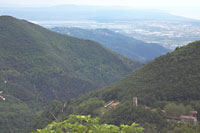THE VILLAGE - lunedì 13 maggio 2024
Sei in: »Portale di Sant'Anna di Stazzema »IL PAESE »THE VILLAGE

HOW TO GET THERE
- 17/01/2006 10:06:17
How to get there
How to get to Sant’Anna di Stazzema
LINKS
- Tuscany Region
Official site of Tuscany Region - Municipality of Stazzema
Web site of Municipality of Stazzema
[THE VILLAGE’S HISTORY]
The origins

The origins of Sant’Anna go back to the XVI century, when it was a livestock’s summer pasture place, on high height, of the little municipality of Farnocchia. For this reason, the village maintain, still today, its own characteristic to be formed by spread houses scattered in the valley (it isn’t the typical village formed by an only agglomeration of houses gathered around the church). The valley is dominated on the east by Gabberi Mountain, on the north by Lieto Mountain, on the west by Rocca Mountain and Ornato Mountain and on the south by Angina little river going to Valdicastello of Pietrasanta.
The hamlets, formed by few houses, have various names: Case di Berna, Sennari, Fabbiani, Colle, Moco, Bambini, Vaccareccia, Argentiera di Sopra e di Sotto, Monte Ornato, Valle Cava, Vinci, Franchi, Pero, La Chiesa, Merli, Coletti and below, toward Valdicastello, i Molini.
Vincenzo Santini, historiographer, about the origins of Sant’Anna, writes : "It is an appendix of houses that, in 1750, were 30 unities; there were 30 families and 174 inhabitants. The small church of Sant’Anna existed since 1687, and it had its own chaplain appointed by the resident confraternity; it had also a Camarlingo, administering some chapel’s propetries. This community reached, in 1784, 192 people, but it had the annuity of only 150 liras and more the obligation to maintain the rectory. This village, like the village of La Culla, are the successors of the village of Vegliatola which was, in XIV century, a little municipality of Pietrasanta." (Santini, "Historical stories of Seravezza, Sazzema and Pietrsanta", edited in 1964).
Before the slaughter of August 12th 1944, the residents touched upon 400 unities and, chiefly, they were constituted by young people; after the slaughter, the survivors were only around 180 and they were, chiefly, men.
In the past, the population of Sant’Anna di Stazzema, like, in general, the High Versilia’s one, was constituted by humble people, got used to work hard to survive. Everything was hard and to conquer, nothing was easy to gain. The families were numerous, they were constituted by grandparents, parents and children (often they are many); everybody, also the children, had to contribute to the maintenance of the family.
The mountain agriculture, the chestnut’s woods and the forest represented, as the livestock, the only resources for the survival. The men had to do the harder work; the tillage of the small piece of ground in which were cultivated: potatoes, wheat, maize, vegetables, but also the hemp to derive its yarn; the cut of the wood to derive the coal; the tillage of the chestnut’s woods to derive the sweet chestnut’s flour which was, at that time, the most important food. The women, instead, further to help the men in these duties, had to provide to the maintenance of the house and of the family, but, above all, they had to attend the livestock, to mow the hay and to spin the wool and the hemp. Also the teenagers had to help the adults in these works, but, above all, their mainly duty was to pasture the small flocks and to supply whit water the livestock and the hause.
Schooling was scarce and chiefly the women weren’t let to go to the school. In the beginning of the thirties, thanks to the initiative of a native sergeant policeman, Severino Bottari, the villagers voluntarily decided to assemble to build their own school, to allow, also to the girls, to have an education. When the building were ready, in its wide classroom also the girls, finally, could take their seat. The new structure also predisposed the residence for the teacher and a room for the assembly of the villagers which was also an emergency room (denominate "Green Cross" association of charity). The "Green Cross" also provided to transport, the serious patients, to the nearest hospital which was the one of Pietrasanta, reachable in about two hours of walking through the mule track.

